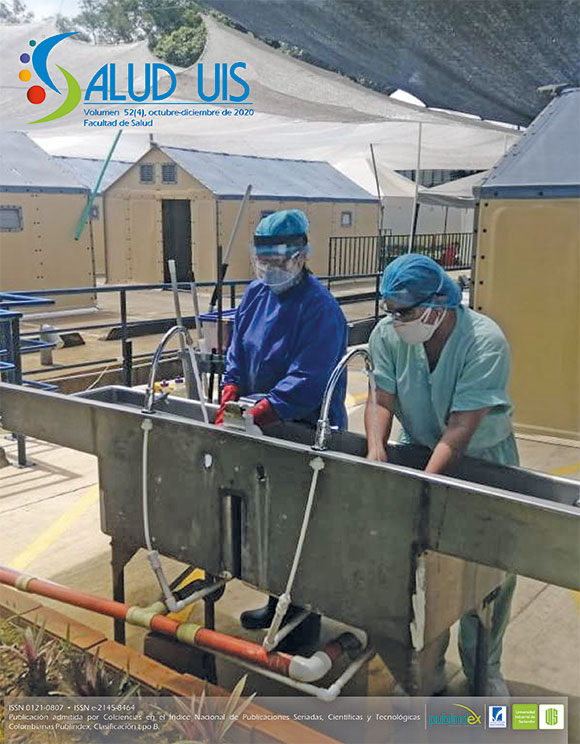Abstract
Introduction: Colombia is the main receiving country of the Venezuelan migrant population. This has involved identifying health needs and responses, particularly those that most threaten the well-being of migrants and refugees, such as infectious diseases. Objective: to analyze the use of health services related to HIV/AIDS, malaria and viral hepatitis in Venezuelan migrants and refugees in Colombia during 2018 and 2019. Methodology: Mixed research study. First, 12 focus groups were conducted with Venezuelan migrant and refugee women and men. Second, an analysis of the use of health services by HIV/AIDS, malaria and viral hepatitis diagnostics was conducted during 2018 and 2019 in six cities with a high migration flow: Barranquilla, Bogotá, Cartagena, Cúcuta, Santa Marta and Riohacha. Results: Health service use by HIV/AIDS, viral hepatitis and malaria events among Venezuelan migrants increased from 2018 (n=1,519) to 2019 (n=3,988). By sex, men used health services most for diagnoses associated with infectious diseases. The qualitative approach identified irregular migration status, deficiencies in primary health care, and limited access to specific protection and early detection of communicable diseases as the main barriers to health care for migrants and refugees. Conclusions: Migration exposes people to a higher risk of contracting infectious diseases such as malaria, viral hepatitis or HIV/AIDS; as well as to inequalities and social exclusion in access to health services for the control and treatment of infectious diseases. Therefore, in migration contexts, equity in health services should be strengthened and access to primary health care, supplies, diagnostic tests and treatment of infectious diseases should be ensured for migrants and refugees.
References
2. MinSalud. Circular externa 05 de 2020. Directrices para la detección temprana, el control y la atención ante la posible introducción del nuevo Coronavirus (2019-nCoV) y la implementación de los planes de preparación y respuesta ante este riesgo. Ministerio de Salud y la Protección Social; 2020.
3. MinSalud. Colombia confirma su primer caso de COVID-19. Boletín de prensa no 050 de 2020. 2020.
https://www.minsalud.gov.co/Paginas/Colombiaconfirma-su-primer-caso-de-COVID-19.aspx
4. INS. Covid-19 en Colombia. Reporte 18-10-2020. COVID-19 en Colombia. 2020. https://www.ins.gov.co/Noticias/paginas/coronavirus.aspx
5. MinSalud. Exceso de mortalidad en Colombia, 2020. MinSalud; 2020. https://www.minsalud. gov.co/sites/rid/Lists/BibliotecaDigital/RIDE/VS/ED/VSP/estimacion-exceso-mortalidad-Colombia-2020.pdf
6. OPS. Técnicas para la medición del impacto de la mortalidad: Años Potenciales de Vida Perdidos. Boletín Epidemiológico. 2003. https://www.uv.es/~lsn/BIOTICS/Demo/Apunts/doc/APVP/be_v24n2-APVP.htm
7. Ministerio de Salud y Protección Social. Guía para el reporte y verificación de las defunciones en SegCOVID-19. MinSalud; 2020. https://www.minsalud.gov.co/sites/rid/Lists/BibliotecaDigital/RIDE/VS/ED/VSP/pspg04guia-reporte-verifiaciondefunciones-segcovid.pdf
8. Beaney T, Clarke JM, Jain V, Golestaneh AK, Lyons G, Salman D, et al. Excess mortality: the gold standard in measuring the impact of COVID-19 worldwide? J R Soc Med. 2020; 113(9): 329-34. doi: https://doi.org/10.1177/0141076820956802
9. Woolf SH, Chapman DA, Sabo RT, Weinberger DM, Hill L. Excess deaths from COVID-19 and other causes. JAMA. 2020; 324(5): 510-3. doi: 10.1001/jama.2020.11787
10. International Transport Forum. Road safety annual report 2019. International Transport Forum; 2019.
https://www.itf-oecd.org/sites/default/files/docs/irtad-road-safety-annual-report-2019.pdf
11. Domingo Alarcón J, Gich Saladich I, Vallejo Cuellar L, Ríos Gallardo AM, Montalvo Arce C, Bonfill Cosp X, et al. Mortalidad por accidentes de tráfico en Colombia. Estudio comparativo con otros países. Rev Esp Salud Publica. 2018; 92: 01807040.
12. Roesch E, Amin A, Gupta J, García-Moreno C. Violence against women during covid-19 pandemic restrictions. BMJ. 2020; 369. doi: https://doi.org/10.1136/bmj.m1712
13. Telles LE de B, Valença AM, Barros AJS, da Silva AG, Telles LE de B, Valença AM, et al. Domestic violence in the COVID-19 pandemic: a forensic psychiatric perspective. Braz J Psychiatry. 2020; ahead of print. doi: https://doi.org/10.1590/1516-4446-2020-1060
14. Lund RG, Manica S, Manica G. Collateral issues in times of covid-19: child abuse, domestic violence and femicide. RBOL. 2020; 7(2): 54-69. doi: http://orcid.org/0000-0002-8352-2888
15. OMS. El género y la COVID-19. Organización Mundial de la Salud; 2020. https://apps.who. int/iris/bitstream/handle/10665/332242/WHO-2019-nCoV-Advocacy_brief-Gender-2020.1-spa.pdf?sequence=1&isAllowed=y
16. World Health Organization, Regional Office for the Western Pacific. Taking sex and gender into account in emerging infectious disease programmes: an analytical framework. 1a ed. WashingtonD.C.: WHO; 2011. http://iris.wpro.who.int/
handle/10665.1/7977
17. Oh I-H, Ock M, Jang SY, Go D-S, Kim Y-E, Jung Y-S, et al. Years of Life Lost Attributable to COVID-19 in High-incidence Countries. J Korean Med Sci. 2020; 35(32). doi: 10.3346/jkms.2020.35.e300
18. OPS. Orientación internacional para la certificación y clasificación (codificación) del COVID-19 como causa de muerte. Basada en la CIE. Organizacion Panamericana de la Salud; 2020. https://www. who.int/classifications/icd/Guidelines_Cause_of_Death_COVID-19-20200423_ES.pdf?ua=1
19. República de Colombia, Ministerio de Salud. Resolución No 008430 de 1993. Por la cual se establecen las normas científicas, técnicas y administrativas para la investigación en salud.
008430 de 1993. 1993 p. 24.

This work is licensed under a Creative Commons Attribution 4.0 International License.
Copyright (c) 2022 Johan Sebastian Ariza-Abril, Juan Carlos Rivillas-García, Ángela Marcela Cifuentes, Mariana Calderón-Jaramillo, Danny Rivera

